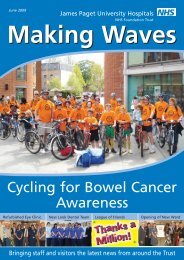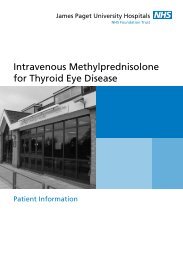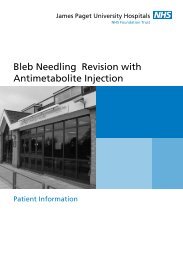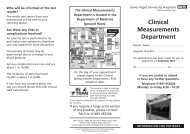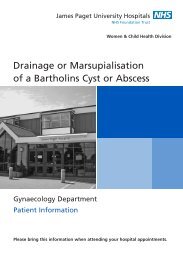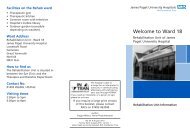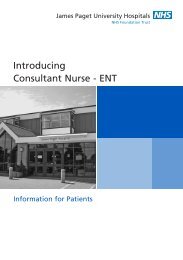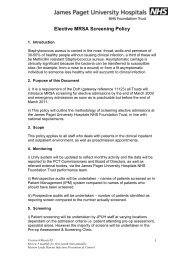Bladder Catheterisation leaflet - James Paget University Hospitals
Bladder Catheterisation leaflet - James Paget University Hospitals
Bladder Catheterisation leaflet - James Paget University Hospitals
Create successful ePaper yourself
Turn your PDF publications into a flip-book with our unique Google optimized e-Paper software.
What is the treatment for?<br />
The paediatrician looking after your child has requested<br />
this investigation to find out if your child’s bladder is<br />
emptying itself properly.<br />
There is a condition called ureteric reflux, which is quite<br />
common. This means that when the bladder empties some<br />
of the urine goes up into the tubes draining the kidneys<br />
(ureters,) rather than passing down the urinary tube<br />
(urethra,) leaving the body. If this is happening there is a<br />
risk of inflammation or scarring of the kidneys.<br />
What will happen on the day?<br />
You will receive a letter asking you to attend the children’s<br />
ward on the day of the micturating cystogram. You will<br />
be asked to attend the ward an hour before the scan to<br />
allow time for preparation. In order to reduce the risk<br />
of infection, it is advisable to double the dose of current<br />
antibiotic given for urine tract infection the day before and<br />
on the day of the procedure.<br />
A micturating cystogram is done by passing a thin soft<br />
plastic tube (catheter) into the bladder via the urethra.<br />
Local anaesthetic cream is applied to the opening of the<br />
urethra to numb the area. A children’s nurse or doctor<br />
will insert the tube and tape to the skin to insure the tube<br />
doesn’t move.<br />
Once the tube is in you will be invited to move to the x-ray<br />
department. In the department the radiologist will then<br />
pass a fluid called the contrast medium into the catheter,<br />
which will fill your child’s bladder. This enables the<br />
radiologist to take the x-rays with the dye in the bladder to<br />
see how the bladder empties.<br />
Benefits of the procedure<br />
The procedure does not take long and provides valuable<br />
information for the paediatrician regarding the presence<br />
of reflux. If detected, it can be treated with medication or<br />
rarely a surgical procedure.<br />
Risks<br />
Like with any x-ray there is some exposure to radiation,<br />
but the amount is low and special precautions are taken to<br />
keep the levels to a minimum.<br />
Very occasionally a child may have a reaction to the<br />
dye; however it is very unusual and can be dealt with<br />
immediately by the medical team.<br />
What happens next?<br />
Following the procedure you will receive an outpatient<br />
appointment with your paediatrician to discuss the results<br />
from the x-rays.<br />
Continue to give your child a double dose of the antibiotics<br />
they were taking before the procedure, and the following<br />
day, preventing any infection.<br />
Continue on a normal dose<br />
thereafter.<br />
We recommend that you<br />
give your child plenty of fluid<br />
following the procedure to<br />
flush the contrast out of their<br />
body and remove any remaining<br />
contrast from the system.




